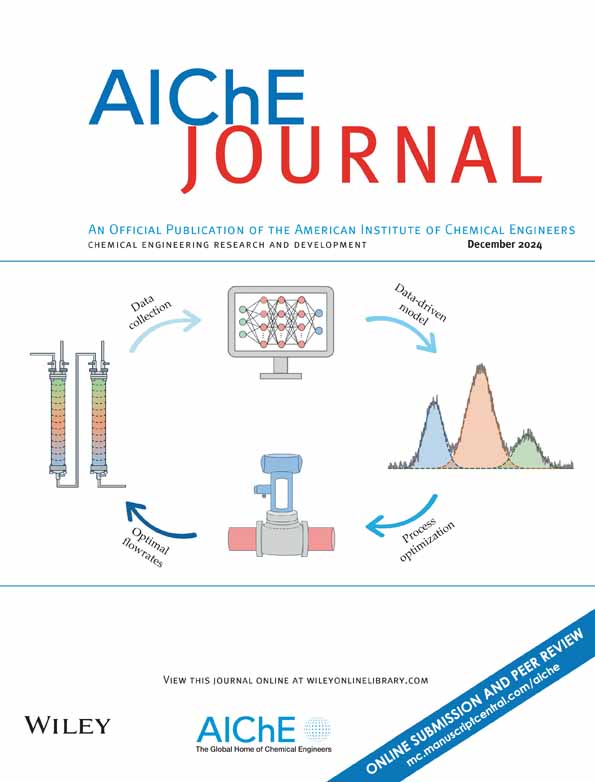Highly dispersed Pd nanoparticles supported on SBA-15@derived C from RF resin for hydrogenation of 2-ethylanthraquinone
IF 3.5
3区 工程技术
Q2 ENGINEERING, CHEMICAL
引用次数: 0
Abstract
Supported Pd-based nanoparticles are widely regarded as the most effective catalysts for 2-ethylthraquinone hydrogenation. Herein, the heteroenergetic dual-supports were prepared by coating resorcinol-formaldehyde (RF) resin on mesoporous SBA-15 to regulate the growth and surface microenvironment of Pd. After calcination and reduction, phenolic hydroxyl groups in the residual carbon layer effectively reduced the Pd particle size, induced the formation of adjacent Pd0–Pdδ+, and created hydrophobicity. Density functional theory calculations revealed that Pd atoms preferentially interact with OH on C, rather than with OH on SBA-15, providing an intrinsic driving force for smaller Pd particle size. The mass ratio of RF to SBA-15 was shown to be a crucial parameter affecting the catalytic performance. At the ratio of 4 (carbon content of 2.02%) the catalyst possesses the smallest Pd particles, 30% Pdδ+ proportion, and higher hydrophobicity, achieving the best catalytic performance, with an activity of 0.57 molH2·gPd−1·min−1 and a selectivity of 95.3%.RF树脂在SBA-15@derived C上负载高度分散的Pd纳米颗粒,用于2-乙基蒽醌的加氢
负载型钯基纳米颗粒被广泛认为是2-乙基醌加氢最有效的催化剂。本文通过在介孔SBA-15表面涂覆间苯二酚-甲醛(RF)树脂制备了杂能双载体,以调节Pd的生长和表面微环境。经过煅烧还原后,残碳层中的酚羟基有效地降低了Pd的粒径,诱导相邻Pd0-Pdδ +的形成,并产生疏水性。密度泛函理论计算表明,Pd原子更倾向于与C上的OH相互作用,而不是与SBA-15上的OH相互作用,这为较小的Pd粒径提供了内在驱动力。结果表明,RF与SBA-15的质量比是影响催化性能的重要参数。在碳比为4(碳含量为2.02%)时,催化剂具有最小的Pd颗粒,30%的Pdδ+比例和较高的疏水性,达到了最佳的催化性能,活性为0.57 molH2·gPd−1·min−1,选择性为95.3%。
本文章由计算机程序翻译,如有差异,请以英文原文为准。
求助全文
约1分钟内获得全文
求助全文
来源期刊

AIChE Journal
工程技术-工程:化工
CiteScore
7.10
自引率
10.80%
发文量
411
审稿时长
3.6 months
期刊介绍:
The AIChE Journal is the premier research monthly in chemical engineering and related fields. This peer-reviewed and broad-based journal reports on the most important and latest technological advances in core areas of chemical engineering as well as in other relevant engineering disciplines. To keep abreast with the progressive outlook of the profession, the Journal has been expanding the scope of its editorial contents to include such fast developing areas as biotechnology, electrochemical engineering, and environmental engineering.
The AIChE Journal is indeed the global communications vehicle for the world-renowned researchers to exchange top-notch research findings with one another. Subscribing to the AIChE Journal is like having immediate access to nine topical journals in the field.
Articles are categorized according to the following topical areas:
Biomolecular Engineering, Bioengineering, Biochemicals, Biofuels, and Food
Inorganic Materials: Synthesis and Processing
Particle Technology and Fluidization
Process Systems Engineering
Reaction Engineering, Kinetics and Catalysis
Separations: Materials, Devices and Processes
Soft Materials: Synthesis, Processing and Products
Thermodynamics and Molecular-Scale Phenomena
Transport Phenomena and Fluid Mechanics.
 求助内容:
求助内容: 应助结果提醒方式:
应助结果提醒方式:


